BUICK PARK AVENUE 1994 Owners Manual
Manufacturer: BUICK, Model Year: 1994, Model line: PARK AVENUE, Model: BUICK PARK AVENUE 1994Pages: 324, PDF Size: 17.01 MB
Page 161 of 324
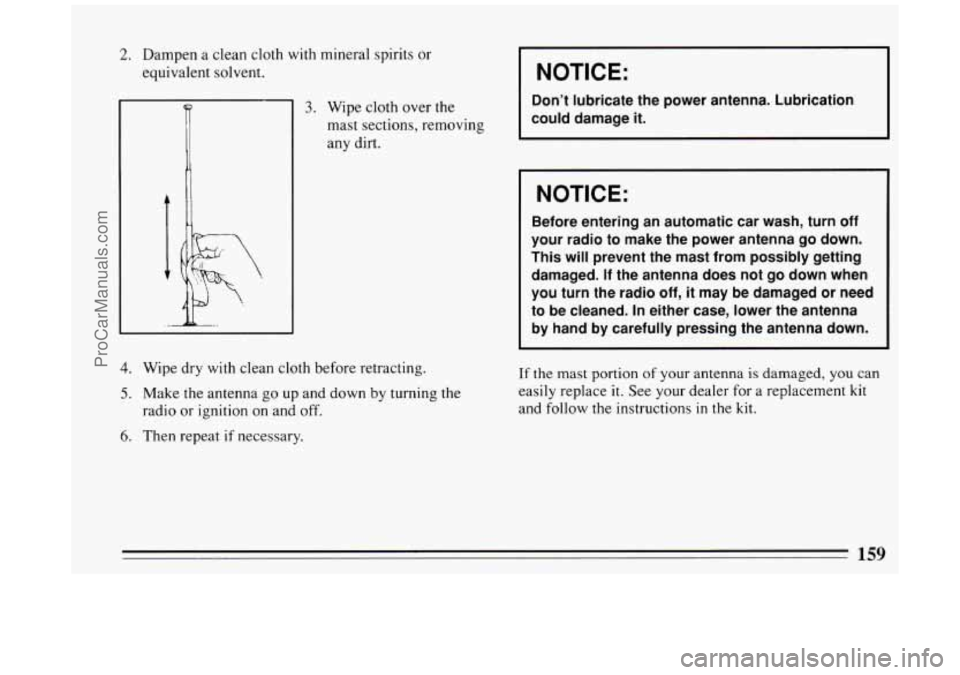
2. Dampen a clean cloth with mineral spirits or
equivalent solvent.
;i 1
. _/
3. Wipe cloth over the
mast sections, remov
any dirt.
4. Wipe dry with clean cloth before retracting.
5. Make the antenna go up and down by turning the
radio or ignition on and off.
6. Then repeat if necessary. ,ing
I NOTICE:
Don’t
lubricate the power antenna. Lubrication
could damage
it.
I NOTICE:
Before entering an automatic car wash, turn off
your radio to make the power antenna go down.
This will prevent the mast from possibly getting
damaged. If the antenna does not go down when
you turn the radio off,
it may be damaged or need
to be cleaned.
In either case, lower the antenna
by hand by carefully pressing the antenna down.
If the mast portion of your antenna is damaged, you can
easily replace it. See your dealer for a replacement kit
and follow the instructions in the kit.
159
ProCarManuals.com
Page 162 of 324
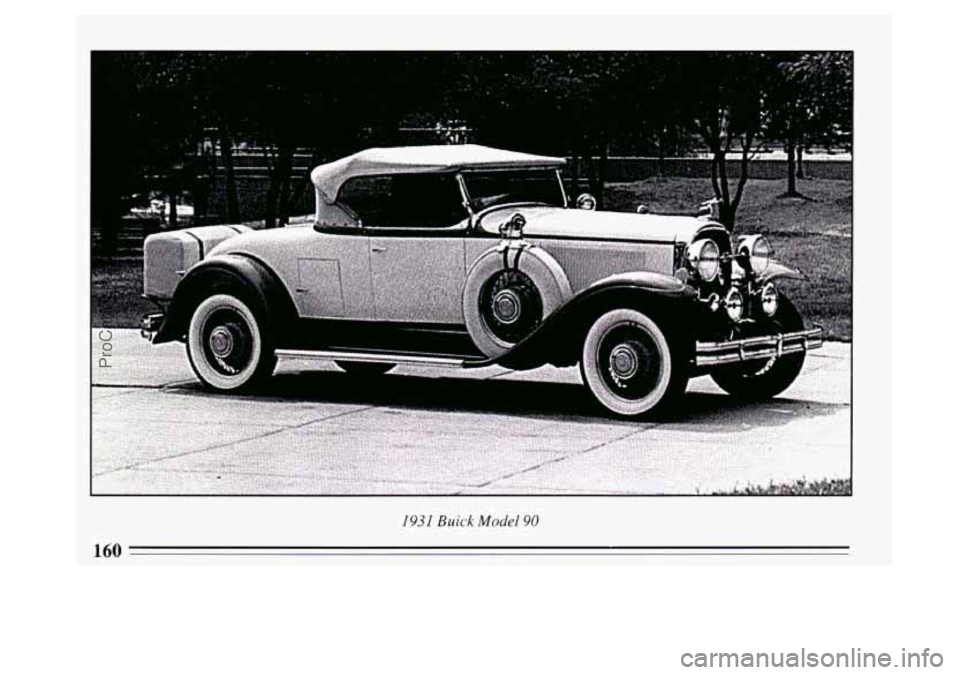
I931 Buick Model 90
160
ProCarManuals.com
Page 163 of 324
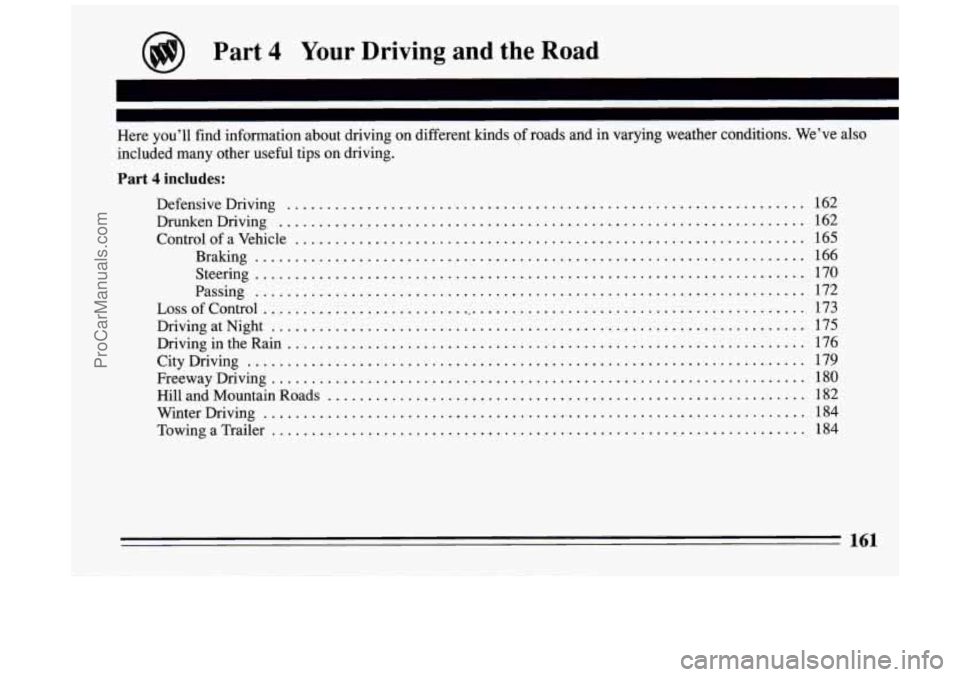
@ Part 4 Your Driving and the Road
Here you’ll find information about driving on different kinds of roads and in varying weather conditions . We’ve also
included many other useful tips on driving
.
Part 4 includes:
DefensiveDriving .................................................................
DrunkenDriving ..................................................................
ControlofaVehicle ................................................................
Braking .....................................................................
Steering .....................................................................
Passing .....................................................................
LossofControl .....................................................................
DrivingatNight ...................................................................
DrivingintheRain .................................................................
CityDriving ......................................................................
FreewayDriving ...................................................................
HillandMountainRoads ............................................................
WinterDriving ....................................................................
TowingaTrailer ...................................................................
162
162
165
166
170 172
173
175 176
179 180
182
184
184
161
ProCarManuals.com
Page 164 of 324
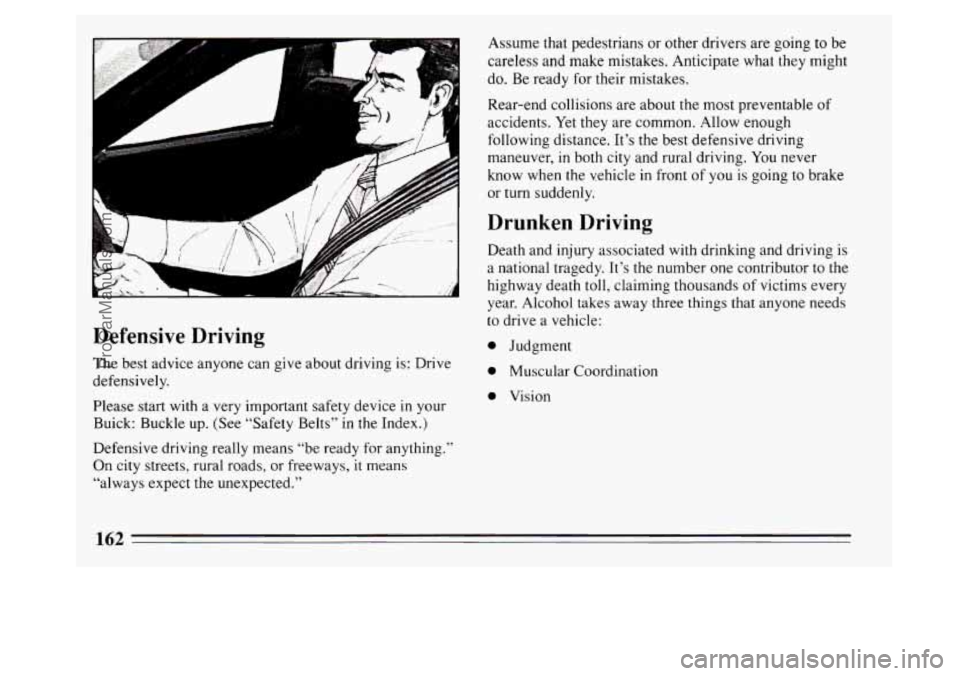
,
1
,
Defensive Driving
The best advice anyone can give about driving is: Drive
defensively.
Please start with a very important safety device in your
Buick: Buckle
up. (See “Safety Belts” in the Index.)
Defensive driving really means “be ready for anything.”
On city streets, rural roads, or freeways,
it means
“always expect the unexpected.” Assume that pedestrians
or other drivers are going to be
careless and make mistakes. Anticipate what they might
do. Be ready for their mistakes.
Rear-end collisions are about the most preventable of
accidents. Yet
they are common. Allow enough
following distance. It’s the best defensive driving
maneuver,
in both city and rural driving. You never
know when the yehicle in front of you is going to brake
or turn suddenly.
Drunken Driving
Death and injury associated with drinking and driving is
a national tragedy. It’s the number one contributor to the
highway death toll, claiming thousands of victims every
year. Alcohol takes away three things that anyone needs
to drive a vehicle:
0 Judgment
0 Muscular Coordination
0 Vision
162
ProCarManuals.com
Page 165 of 324
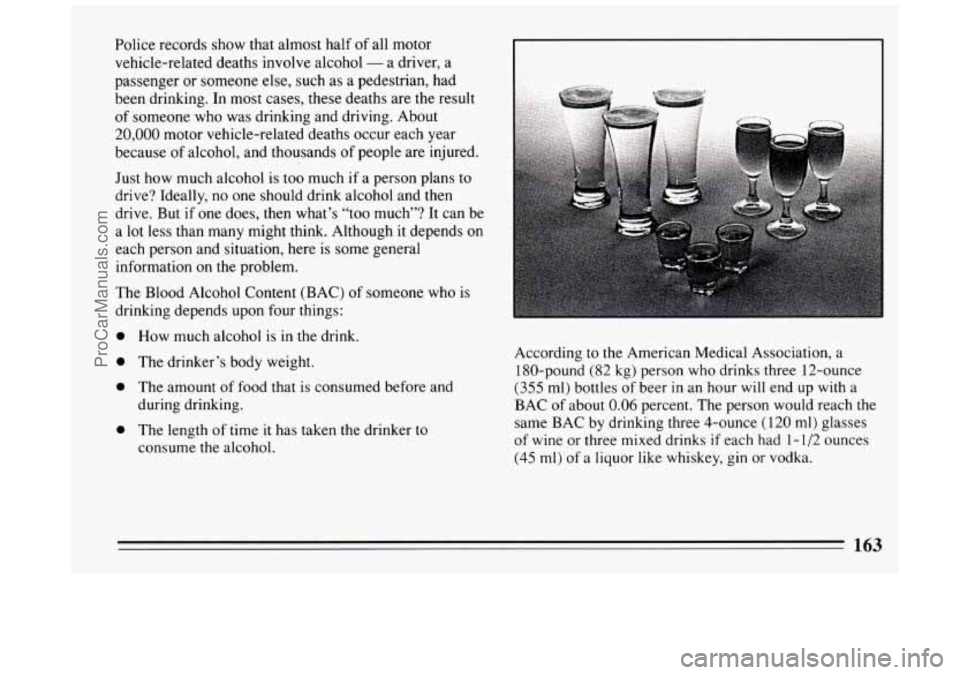
Police records show that almost half of all motor
vehicle-related deaths involve alcohol
- a driver, a
passenger or someone else, such as
a pedestrian, had
been drinking. In most cases, these deaths are the result
of someone who was drinking and driving. About
20,000 motor vehicle-related deaths occur each year
because
of alcohol, and thousands of people are injured.
Just how much alcohol is too much if a person plans
to
drive? Ideally, no one should drink alcohol and then
drive. But if one does, then what’s “too much”? It can be
a lot less than many might think. Although it depends on
each person and situation, here is some general
information on the problem.
The Blood Alcohol Content (BAC)
of someone who is
drinking depends upon four things:
0
0
0
0
How much alcohol is in the drink.
The drinker’s body weight.
The amount of food that is consumed before and
during drinking.
The length of time it has taken the drinker to
consume the alcohol. According
to the American Medical Association, a
180-pound
(82 kg) person who drinks three 12-ounce
(355 ml) bottles of beer in an hour will end up with a
BAC of about
0.06 percent. The person would reach the
same BAC by drinking three 4-ounce (120 ml) glasses
of wine or three mixed drinks if each had 1 - 1/2 ounces
(45 ml) of a liquor like whiskey, gin or vodka.
163
ProCarManuals.com
Page 166 of 324
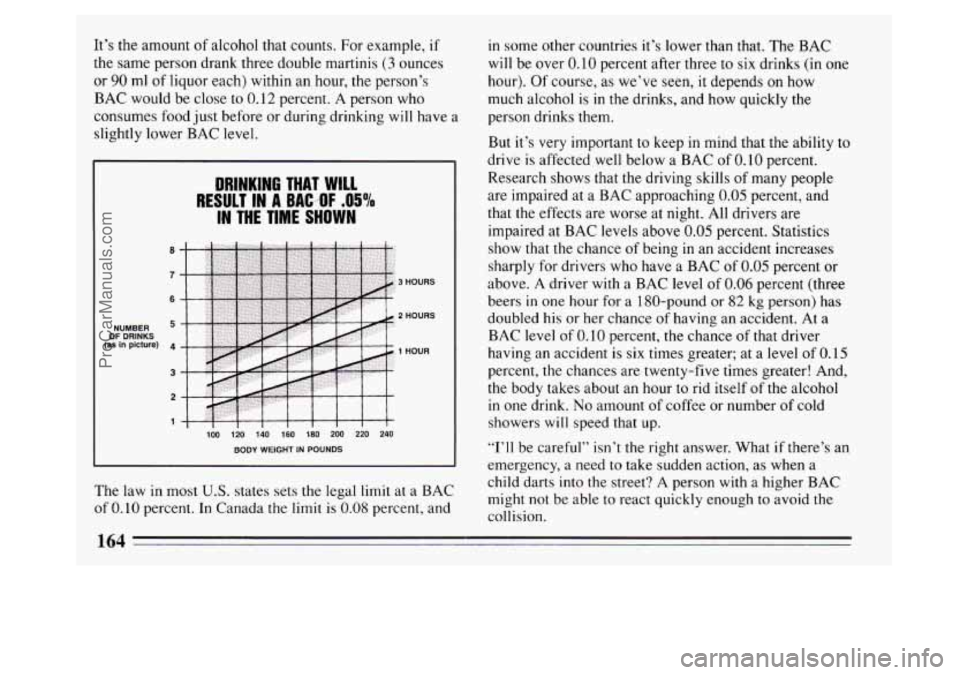
It’s the amount of alcohol that counts. For example, if
the same person drank three double martinis (3 ounces
or 90 ml of liquor each) within an hour, the person’s
BAC would be close to
0.12 percent. A person who
consumes food just before or during drinking will have a
slightly lower BAC level.
NUMBER OF DRINKS (as In picture)
100 120 140 160 180 200 220 240
BODY WEIGHT IN POUNDS
DRINKING THAT WILL
IN THE TIME SHOWN
RESULT IN A BAC.-OF .O5%
3 HOURS
2 HOURS
1 HOUR
The law in most U.S. states sets the legal limit at a BAC
of
0.10 percent. In Canada the limit is 0.08 percent, and in
some other countries it’s lower than that. The BAC
will be over 0.10 percent after three to six drinks (in one
hour). Of course, as we’ve seen, it depends on how
much alcohol
is in the drinks, and how quickly the
person drinks them.
But it’s very important to keep in mind that the ability to
drive is affected well below a BAC of
0.10 percent.
Research shows that the driving skills
of many people
are impaired at a BAC approaching
0.05 percent, and
that the effects are worse at night. All drivers are
impaired at BAC levels above
0.05 percent. Statistics
show that the chance of being in an accident increases
sharply for drivers who have a BAC of
0.05 percent or
above. A driver with a BAC level of 0.06 percent (three
beers
in one hour for a 1 SO-pound or 82 kg person) has
doubled his or her chance of having an accident. At a
BAC level of
0.10 percent, the chance of that driver
having an accident is six times greater; at a
level of 0.15
percent, the chances are twenty-five times greater! And,
the body takes about an hour to rid itself of the alcohol
in one drink.
No amount of coffee or number of cold
showers
will speed that up.
“I’ll be careful” isn’t the right answer. What if there’s an
emergency, a need to take sudden action, as when a
child darts into the street?
A person with a higher BAC
might not be able to react quickly enough to avoid the
collision.
164
ProCarManuals.com
Page 167 of 324
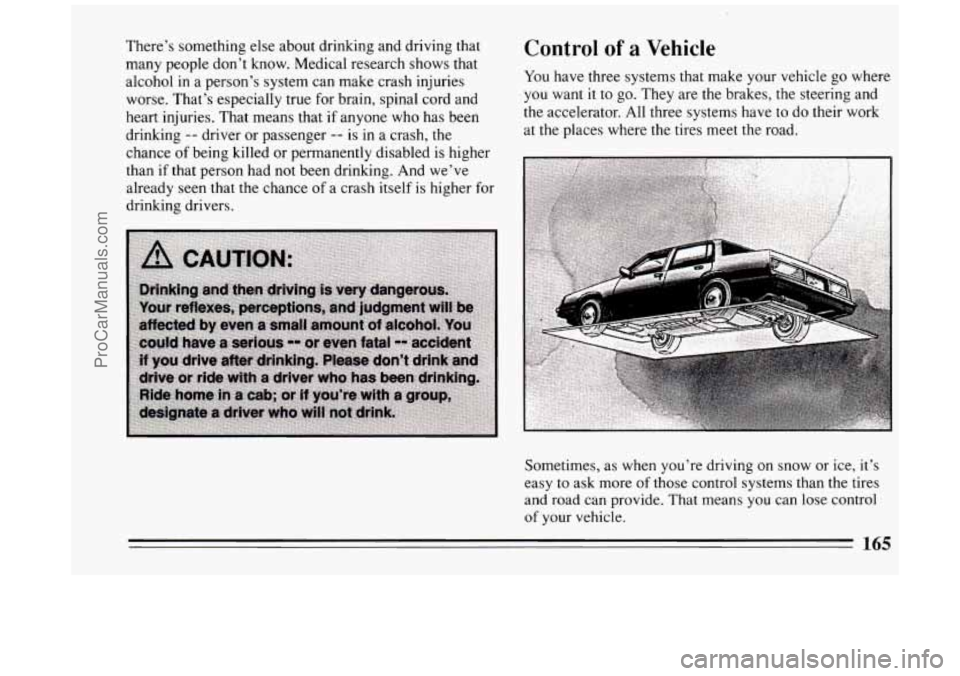
There’s something else about drinking and driving that
many people don’t know. Medical research shows that
alcohol in a person’s system can make crash injuries
worse. That’s especially true for brain, spinal cord and
heart injuries. That means that if anyone who has been
drinking
-- driver or passenger -- is in a crash, the
chance
of being killed or permanently disabled is higher
than if that person had not been drinking. And we’ve
already seen that the chance of a crash itself is higher for
drinking drivers.
Control of a Vehicle
You have three systems that make your vehicle go where
you want it to go. They are the brakes, the steering and
the accelerator. All three systems have
to do their work
at the places where the tires meet the road.
Sometimes, as when you’re driving on snow or ice, it’s
easy to ask more of those control systems than the tires
and road can provide. That means you can lose control
of your vehicle.
165
ProCarManuals.com
Page 168 of 324
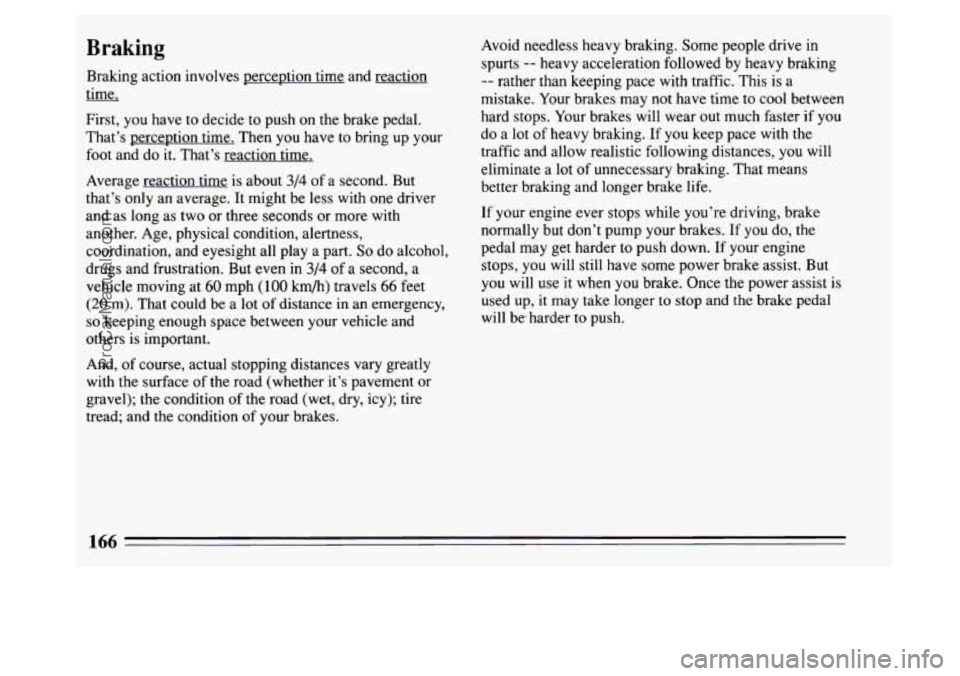
Braking
Braking action involves perception time and reaction
time.
First, you have to decide to push on the brake pedal.
That’s perception time. Then you have
to bring up your
foot and do it. That’s reaction time.
Average reaction time is about
3/4 of a second. But
that’s only an average. It might be less with one driver
and as long as two or three seconds or more with
another. Age, physical condition, alertness,
coordination, and eyesight all play
a part. So do alcohol,
drugs and frustration. But even in
3/4 of a second, a
vehicle moving at
60 mph (100 km/h) travels 66 feet
(20 m). That could be a lot of distance in an emergency,
so keeping enough space between your vehicle and
others is important.
And, of course, actual stopping distances vary greatly
with the surface of the road (whether it’s pavement or
gravel); the condition
of the road (wet, dry, icy); tire
tread; and the condition of your brakes. Avoid
needless heavy braking. Some people drive in
spurts
-- heavy acceleration followed by heavy braking
-- rather than keeping pace with traffic. This is a
mistake. Your brakes may not have time to cool between
hard stops. Your brakes will wear
out much faster if you
do a lot of heavy braking. If you keep pace with the
traffic and allow realistic following distances, you will
eliminate a lot of unnecessary braking. That means
better braking and longer brake life.
If your engine ever stops while you’re driving, brake
normally but don’t pump your brakes. If you do, the
pedal may get harder to push down. If your engine
stops, you will still have some power brake assist. But
you will use it when you brake. Once the power assist is
used up, it may take longer
to stop and the brake pedal
will beharder
to push.
166
ProCarManuals.com
Page 169 of 324
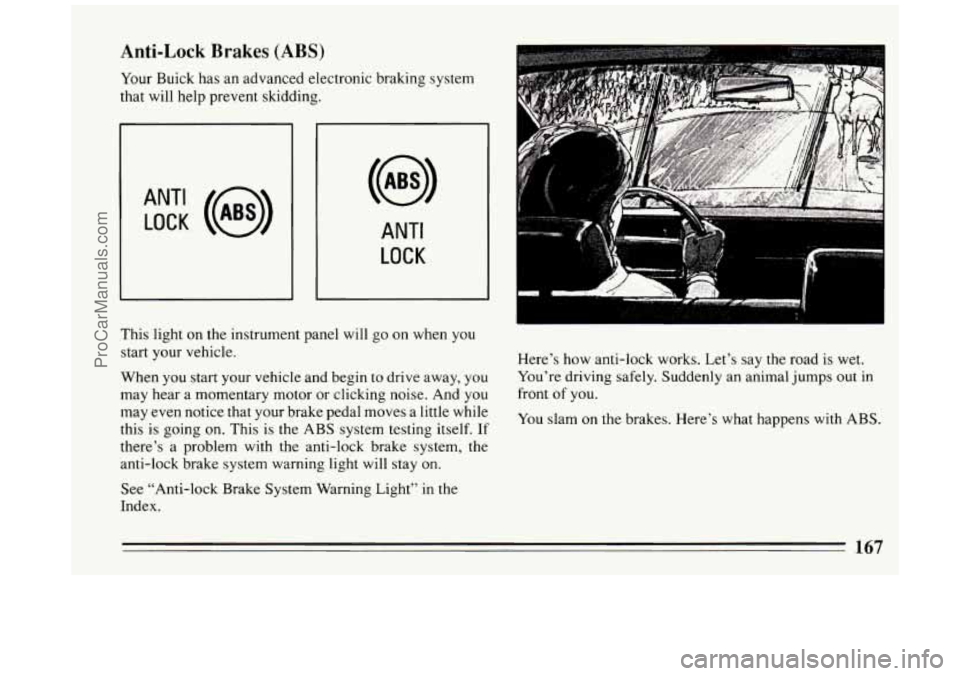
Anti-Lock Brakes (ABS)
Your Buick has an advanced electronic braking system
that will help prevent skidding.
ANT‘ LOCK (@)
ANTI
LOCK
This light on the instrument panel will go on when you
start your vehicle.
When you start your vehicle and begin to drive away, you
may hear a momentary motor or clicking noise. And you
may even notice that your brake pedal moves a little while
this is going
on. This is the ABS system testing itself. If
there’s a problem with the anti-lock brake system, the
anti-lock brake system warning light will stay on.
See “Anti-lock Brake System Warning Light”
in the
Index. Here’s how
anti-lock works. Let’s say the road is wet.
You’re driving safely. Suddenly an animal jumps out in
front of you.
You slam
on the brakes. Here’s what happens with ABS.
167
ProCarManuals.com
Page 170 of 324
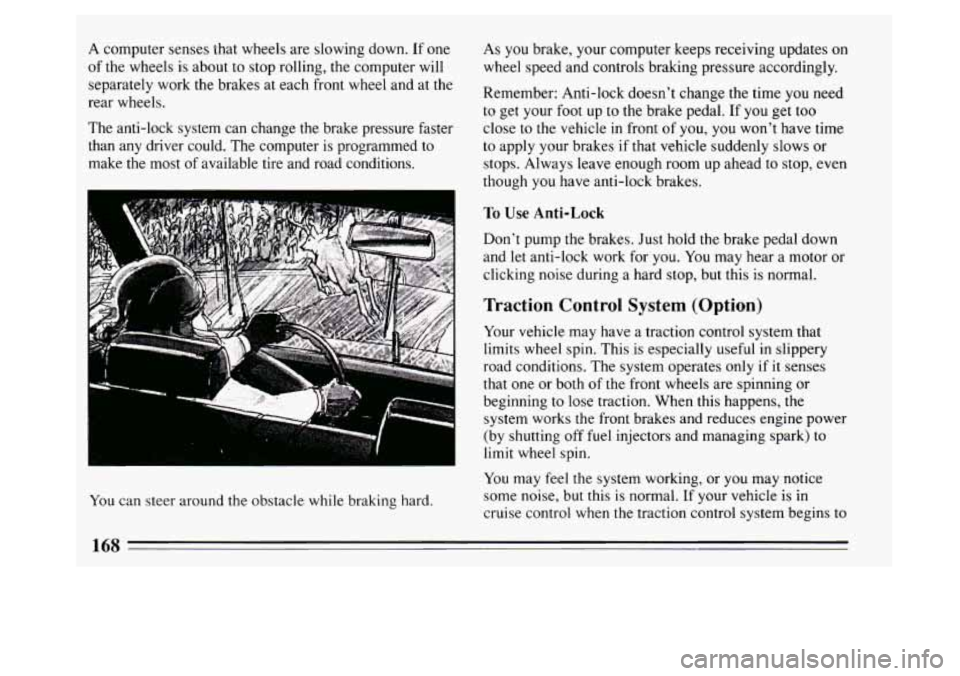
A computer senses that wheels are slowing down. If one
of the wheels is about to stop rolling, the computer will
separately work the brakes at each front wheel and at the
rear wheels.
The anti-lock system can change the brake pressure faster
than any driver could. The computer is programmed to
make the most of available tire and road conditions.
m
b r
You can steer around the obstacle while braking hard. As you
brake, your computer keeps receiving updates on
wheel speed and controls braking pressure accordingly.
Remember: Anti-lock doesn’t change the time you need
to get your foot up to the brake pedal. If you get too
close to the vehicle in front of you, you won’t have time
to apply your brakes if that vehicle suddenly slows or
stops. Always leave enough room up ahead to stop, even
though you have anti-lock brakes.
To Use Anti-Lock
Don’t pump the brakes. Just hold the brake pedal down
and let anti-lock work for you.
You may hear a motor or
clicking noise during a hard stop, but this is normal.
Traction Control System (Option)
Your vehicle may have a traction control system that
limits wheel spin. This is especially useful in slippery
road conditions. The system operates only
if it senses
that one or both of the front wheels are spinning or
beginning to lose traction. When
this happens, the
system works the front brakes and reduces engine power
(by shutting off fuel injectors and managing spark) to
limit wheel spin.
You may feel the system working, or you may notice
some noise, but this
is normal. If your vehicle is in
cruise control when the traction control system begins to
168
ProCarManuals.com